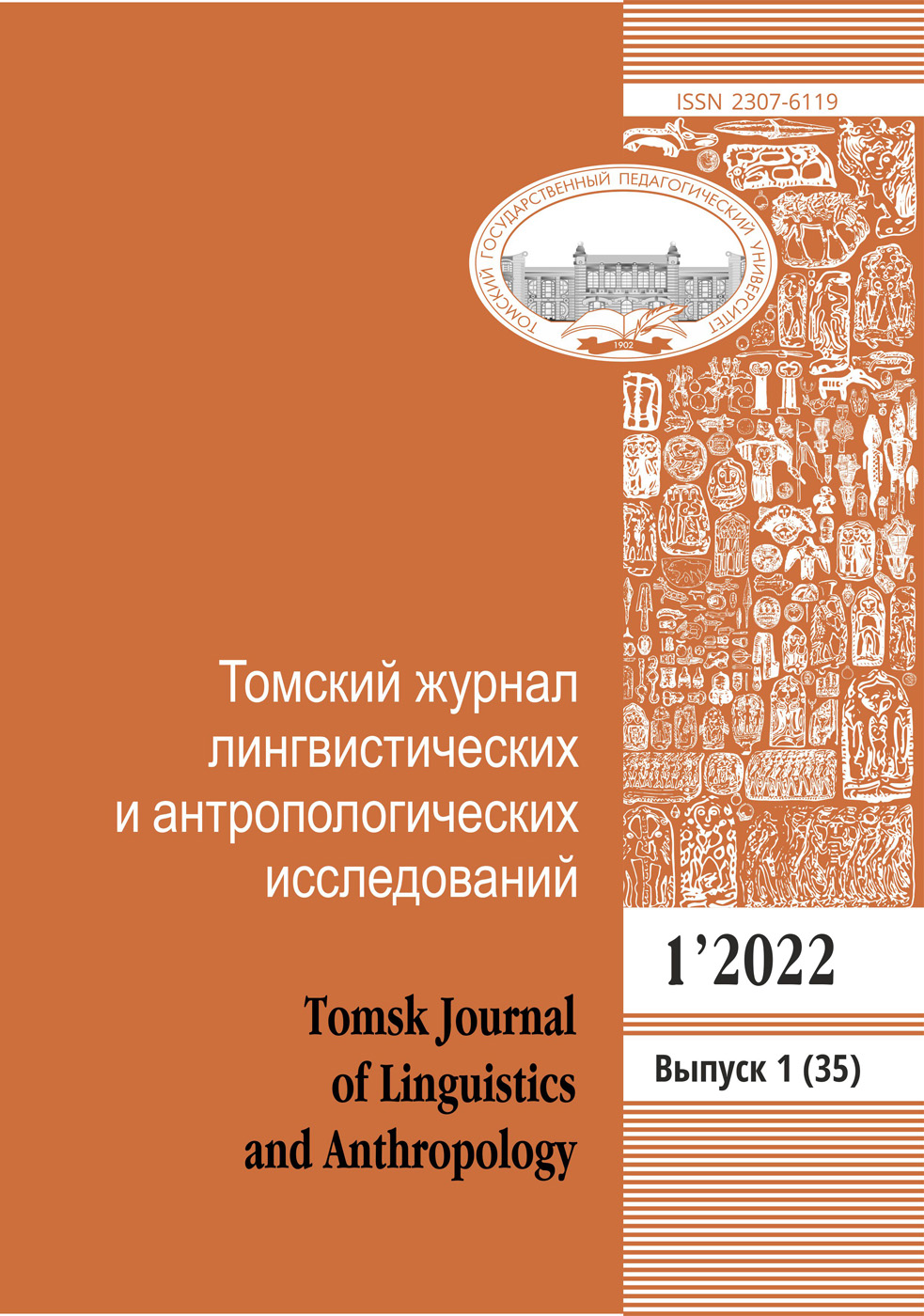To the Problem of Literary Translation of W. Stevens’ Poems into Russian
DOI: 10.23951/1609-624X-2023-1-69-75
The problem of the translatability of a literary text has remained urgent. At different times, there have been debates in literary science about whether it is permissible and possible to recreate an original work by means of a foreign language. In this article, the Bakhtin thesis on the “dialogue of cultures” and the provisions on the fundamental translatability of a work of art developed in the works of Russian comparative scientists are the starting points. The purpose is to analyze the poems of the American modernist poet Wallace Stevens and his Russian – language translations. The program poem by U. Stevens’ “Thirteen Ways to look at the Blackbird” and its translations into Russian served as the material for the study. The study uses the methods of linguo-stylistic analysis of language units, the method of philological analysis of a literary text, and comparative analysis. Creative works of Stevens reflect a general tendency of complexity of the poetic language that was earlier expressed by G. Elliot. Stevens’ poetry remains a mystery, has various interpretations while the author himself does not provide detailed and clear recommendations. The symbol of poetry for Stevens is music – the most abstract kind of art that is why any art should strive towards the state of music. In his poems, Stevens creates a world of imaginary, conditional and mysterious reality. The origins of his poetics go back to romanticism and symbolism, Coleridge’s understanding of the imagination, echoes of Nietzscheanism, Freudian and Jungian motifs. That is the reason why it can be challenging to understand what the author’s poems are about. It leads to multiple interpretations of Stevens’ works. This feature of the poetic style of the American author gives translators freedom when working on Stevens’ texts and actualizes some dominants of original works while obscuring others. An accurate translation of Stevens’ poems is not the same as a successful translation. That is why the researchers recommend to take into consideration his entire artistic heritage (including his theoretical research) when analyzing individual poems. Stevens’ individual poems become parts of a single hypertext that can be understood by having a complete image of an imaginary world created by the author. The paper considers one of the curriculum poems written by Stevens’ “Thirteen ways of looking at a blackbird” and the ways of implementation of the author’s conception in its Russian translations. The analysis of the selected translations made it possible to identify the translation made by Britanishsky as the closest to the concept of equivalence. His translation conveys the lexical content of the original poem, though there are significant deviations that deprive the poem of a holistic reconstruction of the author’s idea.
Keywords: receptive aesthetics, literary translation, adequacy, translation equivalence, artistic method, symbol
References:
1. Bakhtin M. M. Problemy poetiki Dostoyevskogo [Problems of Dostoevsky’s poetics]. Moscow, Khudozhestvennyaya literatura Publ., 1972. 279 p. (in Russian).
2. Bakhtin M. M. Estetika slovesnogo tvorchestva [Aesthetics of verbal creativity]. Moscow, Iskusstvo Publ., 1979. 424 p. (in Russian).
3. Ingarden R. Issledovaniya po estetike [Studies in aesthetics]. Moscow, Inostrannaya literatura Publ., 1962. 571 p. (in Russian).
4. Pasternak B. Zametki perevodchika [Translator’s notes]. Znamya, 1944, no. 1-2 (in Russian).
5. Chukovskiy K. I. Vysokoye iskusstvo [High Art]. Moscow, Sovetskiy pisatel’ Publ., 1968. 384 p. (in Russian).
6. Alekseyeva I. S. Professional’noye obucheniye dlya perevodchikov: uchebnoye posobiye po ustnomu i pis’mennomu perevodu dlya perevodchikov i prepodavateley [Professional training of an interpreter: textbook on interpretation and translation for translators and teachers]. Saint Petersburg, Soyuz Publ., 2001. 288 p. (Series “Translator’s Library”) (in Russian).
7. Lotman Yu. M. O poetakh i poezii. Analis poetichekogo teksta [About poets and poetry. Analysis of the poetic text]. Moscow, 1996. 848 p. (in Russian).
8. Lozinskiy M. L. Ikusstvo poeticheskogo perevoda [The art of poetic translation]. Druzhba narodov, 1955, no. 7 (in Russian).
9. Stevens W. Blagorodnyy voznichiy i zvuchaniye slov [Noble charioteer and the sound of words]. In: Stevens U. Fisgarminiya [Harmonium]. Moscow, Nauka Publ., 2017. 396 p. (in Russian).
10. Kruzhkov G. Zagadki Stivensa, ili Kratkiy samouchitel’ igry na “Fisgarmonii” [Riddles of Stevens, or a Brief tutorial on playing the “Harmonium”]. In: Stivens U. Stikhi. Perevod s angliyskogo i vstupitel’naya stat’ya G. Kruzhkova [Poems. Translation from English and introductory article by G. Kruzhkov] (in Russian). URL: http://magazines.russ.ru/inostran/2008/5/st6.html (accessed 15 January 2022).
11. Kruzhkov G. Temnyy Uolles [Dark Wallace]. Nostal’giya obeliskov: literaturnyye mechtaniya [Nostalgia of obelisks: literary dreams]. Moscow, Novoye literaturnoye obozreniye Publ., 2001. Pp. 467–476 (in Russian). URL: http://www.vavilon.ru/texts/prim/kruzhkov3-11.html (accessed 12 January 2022).
12. Mikluckho Yu. Yu. Kontseptiya iskusstva v tvorchestve U. Stivensa [The concept of art in W. Stevens’s creative work] (in Russian). URL: http://magazines.russ.ru/inostran/2008/5/st6.html (accessed 12 January 2022).
13. Genis A. Igraya v Boga. Vstupitel’naya stat’ya [Playing God. Introduction article]. In: Stevens U. Stikhi. Perevod s angliyskogo G. Kruzhkova [Poems. Translated from English by G. Kruzhkov]. Inotsrannaya literatura, 1998, no. 10 (in Russian). URL: http://magazines.russ.ru/inostran/1998/10/stivens.html (accessed 13 January 2022).
14. Stevens W. Thirteen ways of looking at a blackbird. URL: http://www.uspoetry.ru/poem/133 (accessed 10 January 2022).
15. Stevens W. Trinadtsat’ sposobov narisovat’ drozda [Thirteen ways to draw a blackbird]. Translation from English. Moscow, Rudomino Publ., 2000. 139 p. (in Russian).
16. Stikhotvoreniya: ot Uitmena do Louella [Poems: from Whitman to Lowell]. Moscow, Agraf Publ., 2005. Pp. 47–69 (in Russian).
17. Bashlyar G. Izbrannoye. Poetika prostrantva [Favorites: Poetics of space]. Moscow, Russian Political Encyclopedia Publ., 2004. 376 p. (in Russian).
18. Jung K. G. Ocherki po psikhologii bessoznatel’nogo [Essays on the psychology of the unconscious]. Translation from English. Moscow, 2010. 352 p. (in Russian).
19. Jung K. G. Arkhetip i simvol [Archetype and symbol]. Moscow, Renessans Publ., 1991 (in Russian).
20. Jung K. G. Psikhologiya bessoznatel’nogo, teoriya lichnosti po Yungu, eye struktura, arkhetipy, ekstraversiya i introversiya [Psychology of the unconscious]. Online magazine Razvitiye (in Russian). URL: http://zhurnal-razvitie.ru/psihologiya-lichnosti/karl-gustav-yung-psixologiya-bessoznatelnogo-teoriya-lichnosti-po-yungu-ee-struktura-arxetipy-ekstraversiya-i-introversiya.html (accessed 17 January 2022).
Issue: 1, 2023
Series of issue: Issue 1
Rubric: COMPARATIVE LINGUISTICS
Pages: 69 — 75
Downloads: 312





